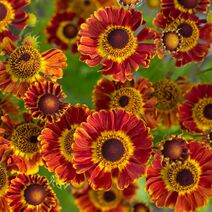Helenium autumnale
| Helenium autumnale | |
 | |
| Light: | |
| Moisture: | |
| Hardiness: | 3 |
| Soil pH: | 5.6-8.4 |
| Height: | 6' |
| Width: | 2' |
| Blooms: | Late Summer-Mid Fall |
| Native to: | |
| Shelter Nectary | |
| Medicinal Rating: | |
| Tea: | Yes |
Helenium autumnale (common name: sneezeweed)
Propagation: Seed - sow spring in a greenhouse. When they are large enough to handle, prick the seedlings out into individual pots and grow them on in the greenhouse for their first winter. Plant them out into their permanent positions in late spring or early summer, after the last expected frosts.
If you have sufficient seed it might be worthwhile trying a sowing in mid to late spring in situ outdoors[1].
Cuttings of soft wood from the base of the plant, June/July in a frame.
Basal cuttings in spring[2]. Harvest the shoots when they are about 10 - 15cm long with plenty of underground stem. Pot them up into individual pots and keep them in light shade in a cold frame or greenhouse until they are rooting well. Plant them out in the summer.
Division in spring or autumn[1]. This needs to be done fairly regularly because the clumps soon become congested[3]. Very easy, larger clumps can be replanted direct into their permanent positions, though it is best to pot up smaller clumps and grow them on in a cold frame until they are rooting well. Plant them out in the spring.
Cultivation: Grows well in ordinary garden soil[4][1], succeeding in most conditions other than boggy soils[3]. It prefers a fertile moisture retentive soil[2] in a sunny position[5][1]. Dislikes dry soil[2].
Plants seem to be immune to the predations of rabbits[3].
A good bee and butterfly plant[6].
A very ornamental plant[4], some named forms have been selected for their ornamental value[7].
Range: Eastern N. America - Quebec to Florida, west to Manitoba and Arizona.
Habitat: Wet meadows and marshes[7]. Rich thickets, meadows and shores[8]. Low, moist calcareous soils in Texas[9].
Medicinal: The dried nearly mature flower heads are used in a powdered form as a snuff to treat colds and headaches[10][11][12]. When made into a tea they are used in the treatment of intestinal worms[11].
The powdered leaves are sternutatory[11][12].
An infusion of the leaves is laxative and alterative[10].
An infusion of the stems has been used as a wash in the treatment of fevers[12].
The plant contains helenalin, a compound that has shown significant anti-tumour activity[11].
Usage: The plant contains helenalin, a compound that has insecticidal properties, though it is also toxic to fish and worms[11].
Pollinators: Bees, lepidoptera
Soil: Can grow in light, medium, and heavy soils.
Flower Type: Hermaphrodite
Known Hazards: The plant is poisonous to ruminants[11]. Contact with the plant might cause dermatitis in sensitive people[11].
Links
References
- ↑ 1.0 1.1 1.2 1.3 Sanders, Thomas. Popular Hardy Perennials. Collingridge, 1926.
- ↑ 2.0 2.1 2.2 Huxley, Anthony. The New Royal Horticultural Society Dictionary of Gardening. MacMillan Press, 1992.
- ↑ 3.0 3.1 3.2 Thomas, Graham. Perennial Garden Plants. J. M. Dent & Sons, 1990.
- ↑ 4.0 4.1 Chittendon, Fred. RHS Dictionary of Plants. Oxford University Press, 1951.
- ↑ International Bee Research Association. Garden Plants Valuable to Bees. International Bee Research Association, 1981.
- ↑ Carter, David. Butterflies and Moths in Britain and Europe. Pan, 1982.
- ↑ 7.0 7.1 Phillips, Roger and Martyn Rix. Perennials - The Definitve Reference. Pan Books, 1991.
- ↑ Lyndon, Merritt. Gray's Manual of Botany. American Book Co, 1950.
- ↑ Diggs, George and Barney Lipscomb. Illustrated Flora of North Central Texas. Botanical Research Institute, 1999.
- ↑ 10.0 10.1 Coffey, Timothy. The History and Folklore of North American Wild Flowers. Facts on File, 1993.
- ↑ 11.0 11.1 11.2 11.3 11.4 11.5 11.6 Foster, Steven and Billy Tatum. Medicinal Plants of Eastern and Central North America. Houghton Mifflin, 1990.
- ↑ 12.0 12.1 12.2 Moerman, Daniel. Native American Ethnobotany. Timber Press, 1998.